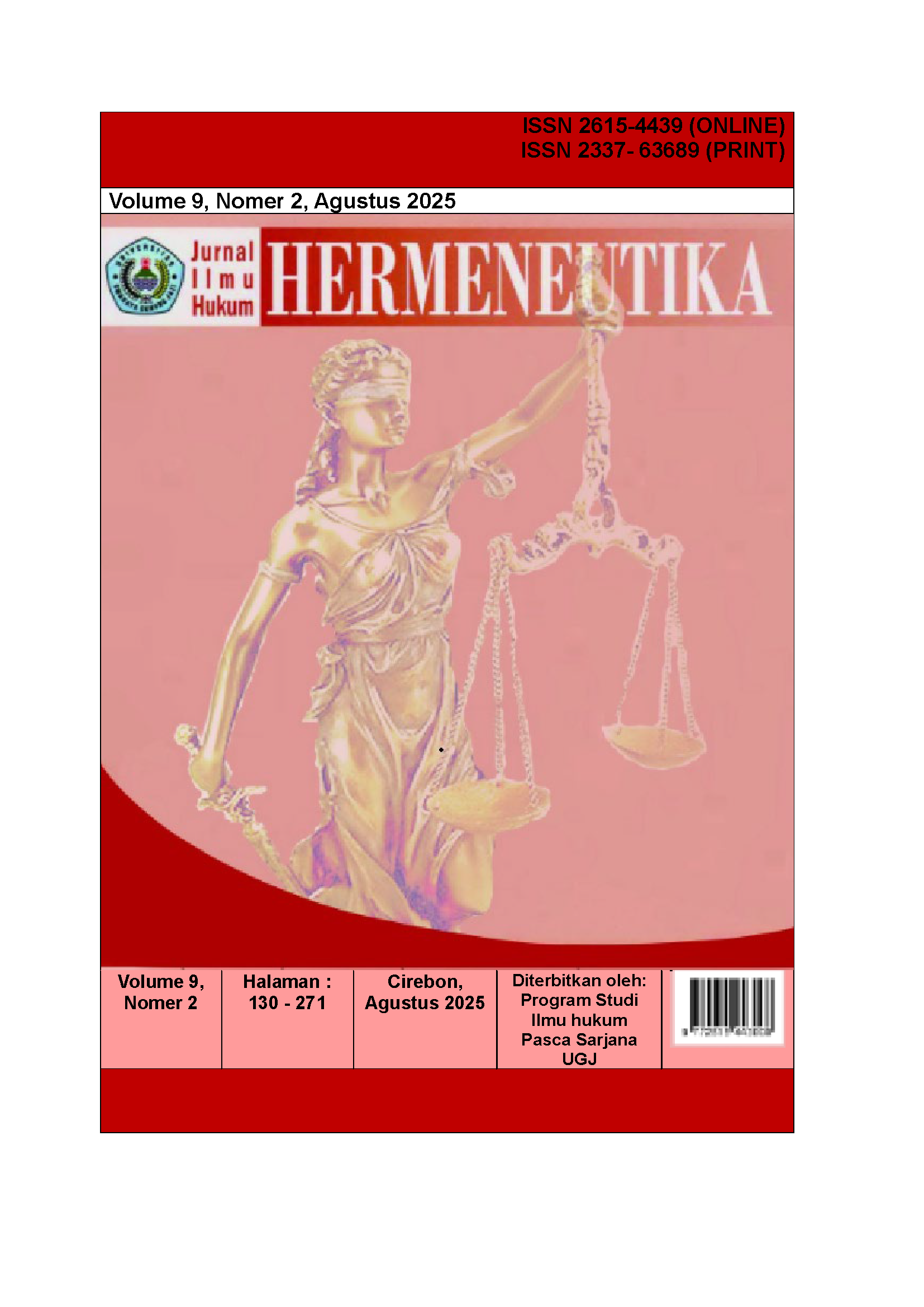LEGAL PROTECTION FOR COPYRIGHT CERTIFICATE HOLDERS OF YOUTUBE VIDEO CONTENT AS FIDUCIARY COLLATERAL BASED ON GOVERNMENT REGULATION NUMBER 24 OF 2022 ON CREATIVE ECONOMY
DOI:
https://doi.org/10.33603/hermeneutika.v9i2.10076Kata Kunci:
Legal Protection, Copyright, Fiduciary CollateralAbstrak
The issuance of Government Regulation of the Republic of Indonesia Number 24 of 2022 concerning the Creative Economy, in which one of the policies is the use of intellectual property certificates as collateral—in this case, YouTube video content which is part of intellectual property—opens up the possibility of YouTube video content being used as fiduciary collateral. This study aims to examine the legal regulation of the use of YouTube video copyright certificates as fiduciary collateral, as well as the legal protection for holders of YouTube video copyright certificates used as fiduciary collateral. The research uses a descriptive-analytical type with a normative juridical approach, data collection techniques include primary and secondary data, and library research to find data related to the research topic. The results show that the legal regulation of the use of YouTube video copyright certificates as fiduciary collateral is already regulated by existing laws and regulations. However, in practice, the use of intellectual property as fiduciary collateral still faces various problems such as the absence of a competent institution to assess the value of YouTube video intellectual property and the lack of a market to absorb intellectual property assets. Hence, legal protection for holders of YouTube video copyright certificates used as fiduciary collateral is currently limited to preventive protection.
Referensi
Asyrofi Aziz et al., “Konten Youtube Dan Dampak Pembentukan Karakter Bagi Anak Beserta Solusinya,” Jurnal Kajian Pendidikan Islam dan Studi Islam 4, no. 2 (2021): 148.
Dzaki Yudi Ananda and M. Halley Yudhistira, “Kepemilikan Hak Kekayaan Intelektual Dan Kinerja Sektor Ekonomi Kreatif Di Indonesia,” Jurnal Kebijakan Ekonomi 15, no. 1 (2021): 1–17.
Gerrid Williem Karlosa Reskin, “Wirdyaningsih, Pengaturan Hak Kekayaan Intelektual Sebagai Jaminan Utang Menurut PP Nomor 24 Tahun 2022”, Pakuan Law Review, Vol. 8, No. 4, 2022.
I Wayan Yasa, “Penerapan Prinsip Kehati-Hatian Dalam Pembuatan Perjanjian Kredit Bank Dengan Jaminan Harta Bersama,” Journal Economic & Business Law Review 2, no. 1 (2022): 48.
Maulidina Laelatul Luqma, Dwi Susilowati, and Novi Primita Sari, “Peran Ekonomi Kreatif Dan Sektor Pariwisata Dalam Pertumbuhan Ekonomi Di Indonesia,” Community Development Journal : Jurnal Pengabdian Masyarakat 4, no. 2 (2023): 3331–3339.
Muhammad Alhada Fuadilah Habib, “Kajian Teoritis Pemberdayaan Masyarakat Dan Ekonomi Kreatif,” Journal of Islamic Tourism, Halal Food, Islamic Traveling, and Creative Economy 1, no. 2 (2021): 106–134.
Shera Aske Cecariyani and Gregorius Genep Sukendro, “Analisis Strategi Kreatif Dan Tujuan Konten Youtube (Studi Kasus Konten Prank Yudist Ardhana),” Prologia 2, no. 2 (2019): 495
Viskha Purwita Lana et al., “Urgensi Kelengkapan Teknis Dalam Regulasi Penggunaan Konten YouTube Sebagai Jaminan,” Padjadjaran Law Review 10, no. 2 (2022)
Unduhan
Diterbitkan
Terbitan
Bagian
Citation Check
Lisensi
Hak Cipta (c) 2025 Anthon Fathanudien, Bias Lintang Dialog, Ramadhan Aji Lesmana Hasyim

Artikel ini berlisensiCreative Commons Attribution-ShareAlike 4.0 International License.
The Authors submitting a manuscript do so on the understanding that if accepted for publication, copyright of the article shall be assigned to Jurnal HERMENUTIKA, Sekolah Pascasarjana Ilmu Hukum. Universitas Swadaya Gunung Jati as publisher of the journal. Copyright encompasses rights to reproduce and deliver the article in all form and media, including reprints, photographs, microfilms, and any other similar reproductions, as well as translations.
Jurnal HERMENEUTIKA, Universitas Swadaya Gunung Jati and the Editors make every effort to ensure that no wrong or misleading data, opinions or statements be published in the journal. In any way, the contents of the articles and advertisements published in Jurnal HERMENEUTIKA are the sole responsibility of their respective authors and advertisers.










